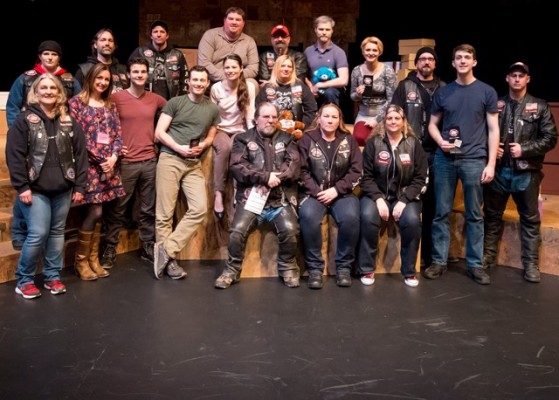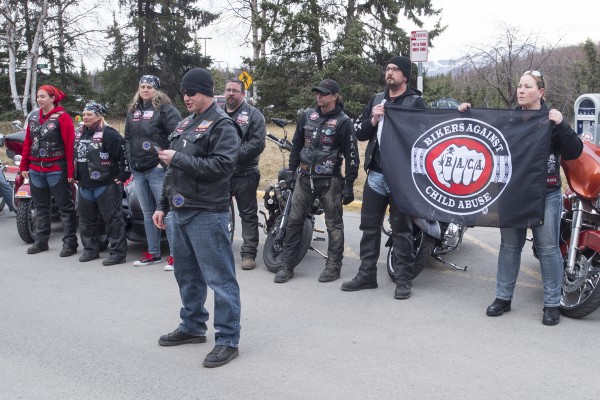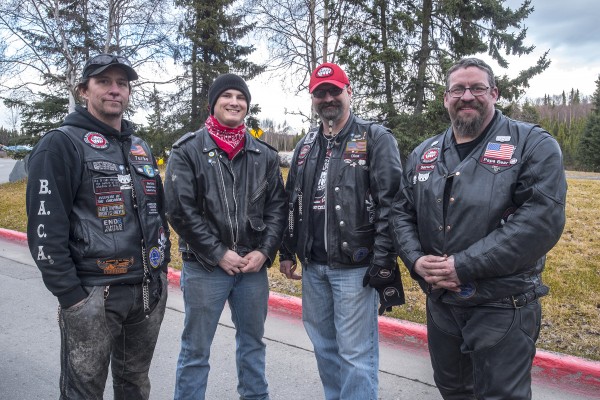Faculty Research Showcase April 5-8: Of bikers, abused children and resilience
by Kathleen McCoy |

Bikers Against Child Abuse logo. The colors and symbols defined on the B.A.C.A. website: Red represents the "blood shed by wounded children"; white represents the "innocence of the children"; black represents the "dark times the child goes through"; the fist represents "our commitment to stop child abuse"; the skull and crossbones symbolizes "death to child abuse"; the chains represent "our united organization."
If you hear the vroom-vroom-vroom of up to 16 motorcycles cruising east campus on Thursday about 7 p.m., don't think a biker gang out on a summer asphalt cruise took a wrong turn. The Fine Arts Building is their destination, where a free (but ticketed) showing of Stalking the Bogeyman begins at 8 p.m. They're coming because of the play.
These Anchorage bikers are not a club or a gang; they are a non-profit committed to empowering abused children by standing by them in their troubled time. They chose to join theatre professor Nova Cunningham's community outreach tied to the current Department of Theatre and Dance production that runs through April 24. The play's theme is childhood rape and its damaging aftermath.
The play and B.A.C.A.'s participation are all a part of the 3rd annual UAA Faculty Research and Creative Activity Showcase this week, an event the public is welcome to attend and enjoy. Campus parking is always free on Fridays.
"It always surprises me when people say to me, 'I didn't know people at UAA were doing that...'," said Diane Hirshberg, a professor of education policy and one of the team of organizers. "We need to reach out and communicate more thoughtfully all the good work happening on our campus, across the natural and social sciences as well as arts and humanities. This showcase is one way to do that."
Bikers and abused children?
That isn't a natural connection. But the Anchorage chapter of the international Bikers Against Child Abuse, or B.A.C.A., is dedicated

The Anchorage B.A.C.A. members join cast and crew of Stalking the Bogeyman after watching a dress rehearsal last week. (Photo courtesy UAA Department of Theatre and Dance)
to standing by abused children so they feel protected and capable of continuing their lives. They're here to support the production's message and to share with the UAA community how they work to empower children.
"As the faculty member in charge of community outreach, I just thought this was a beautiful marriage," said Cunningham. "They represent the cause, what Stalking the Bogeyman is all about. And, forgive me, but they're badass."

B.A.C.A. spokesperson McDreamy speaks after members rode to UAA in support of ending child abuse on April 7, 2016. Photo by OHarra Shipe/UAA.
The surprising connection sparked in Cunningham's intro-to-theatre class when a student with the biker road name of Dice learned of Stalking's dark themes. As a member of the local B.A.C.A. chapter, he thought his fellow members would appreciate knowing about the play. He invited Cunningham to come to a chapter meeting and share details. In late March, the bikers came to campus as a group to watch the last dress rehearsal. Shortly after, they committed to participating with her in the Faculty Showcase.
So tomorrow evening (April 7), they'll do what bikers do: Ride up en masse, so that you very specifically notice them. Then, they'll share some details on how they work with abused children.
Anchorage chapter
To learn more about the local chapter, Dice put me in touch with their public relations contact, McDreamy, who filled in details. Members always go by their road names, they explained.
B.A.C.A. began in 1995, the work of a Provo, Utah-based licensed clinical social worker and registered play therapist, John Paul "Chief" Lilly, who also taught part time at Brigham Young University. In a short video on their website, Chief explains how he asked a few biker friends to help him support one particular child. More than 25 showed up on their bikes and made a big impression, and the idea of B.A.C.A. was born. To paraphrase his video remarks, Chief said plenty of people would like to take a stand against child abuse; they just don't have a path or an avenue to do that. B.A.C.A. makes at least one path. Another news story about work the group does put it this way: The world is not evil because people do bad things. The world is evil because people stand by and do nothing. B.A.C.A. is about not letting that happen.
McDreamy, now stationed at Joint Base Elmendorf-Richardson, first engaged with B.A.C.A. in Shreveport, Louisiana when he'd just gotten a bike and was learning to ride. An acquaintance mentioned the chapter, and eventually McDreamy checked it out and joined.
"I never looked back," said McDreamy. "You go on that first ride and see how it affects a child. It brings something more serious to my life, a way to give back to the community. Now, I have a reason to ride."
When he transferred to Alaska in 2013, McDreamy asked if he could start a chapter here. The Louisiana state president allowed him to retain his membership with their group while he worked to launch a northern group.
A new chapter takes time and work to found. Members undergo a federal fingerprint background check. Training comes through annual conference workshops and up to 200 hours of online webinars on topics dealing with childhood trauma, effective communication with victims of childhood abuse, biker conduct with children and more.
"Child communication is a big one," McDreamy said. "We learn the importance of getting on their level so we aren't big scary people. We take a knee or sit beside them. We never wear sunglasses when we're around our kids, so they can see our eyes. Allowing children to say hello or goodbye their way is a big thing with these kids. Side hugs, or a fist bump, however they want to say hi and bye. We learn all of that in webinars."
The Anchorage group worked their way through all the start-up details. "Last December, we became a full-fledged chapter," McDreamy said. Kenai has a temporary chapter working. McDreamy said some Kenai members may join them for Thursday's ride to UAA.
But McDreamy confirmed that the biker brand is part of their persona. "Bikers definitely don't have a soft reputation, and that helps us do what we have to do," he said. "We have this term: Big Uglies, bikers wearing their big beards and black leather. We bring all our Big Uglies around, and we're bigger and uglier than the bad guy that was doing the harm."
Road names and teddy bears
The B.A.C.A.org website describes four levels of intervention that a chapter can initiate. After referral through social service agencies, B.A.C.A. stages a showy group ride right

B.A.C.A. Riders pose for photo after riding in to UAA in suppot of ending child abuse, a cause they actively support. Photo by OHara Shipe/UAA.
up to the home of recovering child. In the presence of a parent or guardian, the bikers present a child-size vest with B.A.C.A. patch and stickers, and let the family snap a photo of the child with his or her new biker family.
They also provide a teddy bear "filled with hugs and love." At that first intervention, each B.A.C.A. member hugs and passes the teddy, then they hand it to the child. If the teddy is ever empty of love, say the bikers, "just call us and we'll return to fill it up again."
McDreamy said B.A.C.A. worldwide has helped infants through 18-year-olds. They'll accompany them to court. They'll stand watch 24/7 if a child feels threatened or in harm's way and ensure they are empowered and feel safe. A B.A.C.A. chapter can increase its profile and visibility in a troubled neighborhood, even going door to door to explain its presence and hand out resource materials related to stopping child abuse.
McDreamy said a B.A.C.A. chapter will alert local police when they have a big ride planned, because "sometimes people call the police and say, 'Hey, there are all these bikers in my neighborhood, what's going on?' So we let them know who we are and what we're doing there."
"We are not vigilantes," he added. "We make a commitment to show up for a kid. If they call, we show up. But also, we call the cops immediately if the child is in any danger."
Other rich aspects of the faculty showcase
Most of the time faculty are up in the front of classrooms or laboratories, doing their amazing job of teaching. Or, they're deeply engaged in their research, but with few outlets to share it with us.
The rare opportunity to get a glimpse into the working research of UAA faculty usually comes but once a year-during this third showcase, sponsored by Dr. Helena Wisniewski, vice provost of research and graduate studies, and the Faculty Senate Research and Creative Activity Committee. For the first time, the showcase organizers chose a singe theme, "Strength and Resiliency in a Changing World."
The showcase lasts Tuesday through Friday, April 5-8. At least 16 academic posters will be on display Tuesday in the ConocoPhillips Integrated Science Building lobby. Poster topics range from presentations by faculty in history, computer science and engineering, rural and K-12 education, sociology, biology, health sciences and distance learning, among others.
In addition, faculty present roughly half-hour opportunities to learn about their work. Events begin Thursday at 5:30 p.m. with an interactive exercise with theatre professors Ty and Shelly Hewitt, "using a generative technique to quickly create a piece of dynamic staging that opens up dialogue around themes of strength and resilience." SOther faculty sessions continue Friday, including a presentation on alcohol and Tlingit culture, salmon modeling, early childhood mental health, winter design, plasma as matter, the utopian model, and psychology and theatre professors discussing Stalking the Bogeyman as a means of confronting sexual violence. Find the full showcase schedule here.
"I love seeing the breadth of work done at UAA, as well as learning from my colleagues" said Hirshberg. "We have amazing creative work coming out of UAA, as well as research that is groundbreaking and exciting. But we rarely take time to go outside our disciplinary circles and learn what's happening across campus. This is a fun opportunity to share with and learn from each other and deepen our appreciation of the strengths of our institution."
A capstone for the event happens Friday from 5:30-7 p.m. when a plenary panel of community leaders discusses the "Meaning of UAA Research and Creative Activity to the Anchorage Community." Participants include Julie Decker with the Anchorage Museum, Joe Beedle wth Northrim Bank, Jonathan Bittner with Anchorage Economic Development Corporation and Matthew Tanibor with BP Corrosion Engineering.
"We thought of the plenary as a way to share both with the Anchorage community and our faculty what community leaders see as the impact of our creative and research work," Hirshberg said. "It's the other side of the story about what faculty are doing at UAA. Sometimes here we feel like we are working in a vacuum. This allows us to both understand and celebrate how we contribute to making Anchorage a better place to live and work."
Written by Kathleen McCoy, UAA Office of University Advancement
 "Faculty Research Showcase April 5-8: Of bikers, abused children and resilience" is licensed under a Creative Commons Attribution-NonCommercial 4.0 International License.
"Faculty Research Showcase April 5-8: Of bikers, abused children and resilience" is licensed under a Creative Commons Attribution-NonCommercial 4.0 International License.














